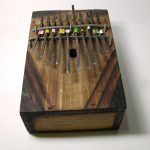Musical instruments
30 Other resonators
Other resonating systems

Strings and air columns resonate, but so do other systems. Any resonating systems can be used to control the pitch produced by a musical instrument. Many woodwinds (like clarinets and saxophones) use conical air columns. Drums have thin membranes that resonate. Metal and wood bars are used in percussion instruments like xylophones, marimbas, glockenspiels, and thumb pianos.
How do these systems work? How do they compare to strings and air columns?
Harmonic vs. anharmonic systems
The math for strings and air columns is relatively simple- overtones have frequencies that are whole number multiples of the fundamental. resonating systems that follow this pattern are called harmonic. Examples of harmonic systems include strings, (cylindrical) air columns and conical air columns. The word harmonic reflects the fact that Western music is built on intervals that ratios of whole numbers. Overtones of harmonic systems sound pleasing when played with the fundamental (to people used to listening to Western music).
Many systems- like thin membranes and vibrating bars- have overtones that do not follow this simple pattern. Systems with overtones that are not integer multiples of the fundamental are called anharmonic. Metal bars, bells and circular membranes are examples of anharmonic systems. Overtones of these anharmonic systems often sound as if they “clash” with the fundamental.
Metal bars
Hyperphysics has an excellent quick reference guide for the resonance of metal bars. [1] This webpage is especially useful if you are trying to make musical instruments based on vibrating bars, like thumb pianos, wind chimes or xylophones. For those interested in DIY wind chimes, Lee Hite’s wind chime website [2] is must!
Drum Heads
For info about standing waves and resonances on drum heads, visit Hyperphysics’ quick reference on circular membranes. [3]
Image credit
Thumb piano (by Ludwig D. Omen from Wikimedia Commons CC-BY) [4]
- Nave, R. (no date). Bar vibrational modes. Retrieved from http://hyperphysics.phy-astr.gsu.edu/hbase/Music/barres.html ↵
- Hite, L. (2017). Say it with chimes. Retrieved from http://leehite.org/Chimes.htm ↵
- Nave, R. (no date). Circular membrane modes. Retrieved from http://hyperphysics.phy-astr.gsu.edu/hbase/Music/barres.html ↵
- Omen, Ludwig (2009, November 7). Kalimba. Retrieved from https://commons.wikimedia.org/wiki/File:Kalimba_(thumb_piano)_(photozou_29416325)_by_Ludwig_D._Omen.jpg ↵
